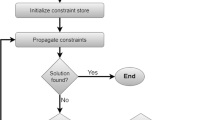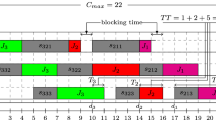Abstract
Multiple-job-class sequencing problems solve a group of jobs belonging to multiple classes, where to decrease the processing time, jobs in the same class tend to be performed together with the same setup time. In contrast, customer order scheduling problems focus on completing all jobs (belonging to different classes) in the same order at the same time to reduce shipping costs. Because related studies on multiple-job-class sequencing problems with more than one criterion are quite limited in the current research community, this study investigates tri-criteria scheduling problems with multiple job classes and customer orders on a single machine, where the goal is to minimize a linear combination of the makespan, total completion times of all jobs, and sum of the ranges of all orders. Due to the high complexity of the proposed problem, mixed integer programming is developed to formulate the problem, and a branch-and-bound method along with a lower bound and a property is utilized for finding the optimal schedules. Then, two heuristics and a simulated annealing algorithm are proposed to solve the problem approximately. The simulation results of the proposed heuristics and algorithm are evaluated through statistical methods.



Similar content being viewed by others
Data availability
The corresponding author will provide the relevant datasets upon request.
Code availability
The corresponding author will provide the Fortran programming code upon request.
References
Allahverdi A, Gupta JND, Aldowaisan T (1999) A review of scheduling research involving setup considerations. Omega 27(2):219–239
Allahverdi A, Ng CT, Cheng TCE, Kovalyov MY (2008) A survey of scheduling problems with setup times or costs. Eur J Oper Res 187(3):985–1032
Allahverdi A (2015) The third comprehensive survey on scheduling problems with setup times/costs. Eur J Oper Res 246(2):345–378
Della Croce F, Narayan V, Tadei R (1996) The two-machine total completion time flow shop problem. Eur J Oper Res 90:227–237
Dileepan P, Sen T (1988) Bicriterion static scheduling research for a single machine. Omega 16:53–59
Erel E, Ghosh JB (2007) Customer order scheduling on a single machine with family setup times: complexity and algorithms. Appl Math Comput 185:11–18
Framinan JM, Perez-Gonzalez P, Fernandez-Viagas V (2019) Deterministic assembly scheduling problems: a review and classification of concurrent-type scheduling models and solution procedures. Eur J Oper Res 273:401–417
Fry TD, Armstrong RD, Lewis H (1989) A framework for single machine multiple objective sequencing research. Omega 17:595–607
Gupta JND, Ho JC, van der Veen JA (1997) Single machine hierarchical scheduling with customer orders and multiple job classes. Ann Oper Res 70:127–143
Hassan DA, Amiri NM, Ramadan AM (2022) Solving three objectives single-machine scheduling problem using fuzzy multi-objective linear programming. Tikrit J Pure Sci 27(6):82–87
Hollander MD, Wolfe A, Chicken E (2014) Nonparametric statistical methods, 3rd edn. Wiley, Hoboken
Hosseinzadeh MR, Heydari M, Mazdeh MM (2022) Mathematical modeling and two metaheuristic algorithms for integrated process planning and group scheduling with sequence-dependent setup time. Oper Res Int J 22:5055–5105
Hsu SY, Liu CH (2009) Improving the delivery efficiency of the customer order scheduling problem in a job shop. Comput Ind Eng 57:856–866
Kirkpatrick S, Gellat CD, Vecchi MP (1983) Optimization by simulated annealing algorithm. Science 220:671–680
Kim SC, Bobrowski PM (1997) Scheduling jobs with uncertain setup times and sequence dependency. Omega 25(4):437–447
Klamroth K, Wiecek MM (2001) A time-dependent multiple criteria single-machine scheduling problem. Eur J Oper Res 135:17–26
Kovalenko YV, Zakharov AO (2020) The Pareto set reduction in bicriteria customer order scheduling on a single machine with setup times. In: Journal of physics: conference series, IOP Publishing. p 012087
Liaee MM, Emmons H (1997) Scheduling families of jobs with setup times. Int J Prod Econ 51(3):165–176
Liao CJ (1993) Tradeoff between setup times and carrying costs for finished items. Comput Oper Res 20:697–705
Li LY, Lin WC, Bai D, Zhang X, Azzouz A, Cheng SR, Wu YL, Wu CC (2023) Composite heuristics and water wave optimality algorithms for tricriteria multiple job classes and customer order scheduling on a single machine. Int J Ind Eng Comput 14(2):265–274
Lin BMT, Yin PY, Liu YS (2013) Sequence-dependent scheduling with order deliveries. Appl Math Comput 222:58–71
Lin BMT, Kononov AV (2007) Customer order scheduling to minimize the number of tardy jobs. Eur J Oper Res 183(2):944–948
Lin WC, Zhang X, Liu X, Hu KX, Cheng SR, Azzouz A, Wu CC (2023) Sequencing single machine multiple-class customer order jobs using heuirstics and improved simulated annealing algorithms. RAIRO Op Res 57:1417–1441
Liu CH (2009) Lot streaming for customer order scheduling problem in job shop environments. Int J Comput Integr Manuf 22(9):890–907
Liu CH (2010) A coordinated scheduling system for customer orders scheduling problem in job shop environments. Expert Syst Appl 37:7831–7837
Qian J, Lin H, Kong Y, Wang Y (2020) Tri-criteria single machine scheduling model with release times and learning factor. Appl Math Comput 387:124543
Shi Z, Wang L, Liu P, Shi L (2017) Minimizing completion time for order scheduling: formulation and heuristic algorithm. IEEE Trans Autom Sci Eng 14(4):1558–1569
Shi Z, Huang Z, Shi L (2018) Customer order scheduling on batch processing machines with incompatible job families. Int J Prod Res 56(1–2):795–808
Soltani R, Jolai F, Zandieh M (2010) Two robust meta-heuristics for scheduling multiple job classes on a single machine with multiple criteria. Expert Syst Appl 37:5951–5959
Suma T, Murugesan R (2019) Mathematical model and heuristic based subtask scheduling algorithm for order scheduling. AIP Conf Proc 2095:030026-1–030026-9
Suerie C (2006) Modeling of period overlapping setup times. Eur J Oper Res 174(2):874–886
Suerie C, Stadtler H (2003) The capacitated lot-sizing problem with linked lot-sizes. Manag Sci 49:1039–1054
van Donk DP, van Doorne R (2016) The impact of the customer order decoupling point on type and level of supply chain Integration. Int J Prod Res 54(9):2572–2584
Xu X, Ma Y, Zhou Z, Zhao Y (2015) Customer order scheduling on unrelated parallel machines to minimize total completion time. IEEE Trans Autom Sci Eng 12(1):244–257
Yang WH (1999) Survey of scheduling research involving setup times. Int J Syst Sci 30(2):143–155
Yang J (2011) Customer order scheduling in a two machine flowshop. Int J Manag Sci 17(1):95–116
Yedidsion L (2012) Bi-criteria and tri-criteria analysis to minimize maximum lateness makespan and resource consumption for scheduling a single machine. J Sched 15:665–679
Ying KC, Pourhejazy P, Cheng CY, Syu RS (2020) Supply chain-oriented permutation flowshop scheduling considering flexible assembly and setup times. Int J Prod Res 61(1):258–281
Zangwill WI (1987) From EOQ towards ZI. Manag Sci 33:1209–1223
Zhao Y, Xu X, Li H, Liu Y (2018) Stochastic customer order scheduling with setup times to minimize expected cycle time. Int J Prod Res 56(7):2684–2706
Acknowledgements
Authors thank the editor and two reviewers for their useful suggestions and positive comments. This article was supported in part by the Ministry of Science and Technology of Taiwan, MOST 110-2221-E-035-082- MY2, and National Science and Technology Council of Taiwan (NSTC) under Grant No. NSTC 112-2221-E-035- 060-MY2. and in part by the Major Program of the National Natural Science Foundation of China\ (11991022), the National Natural Science Foundation of China (11971443.
Funding
Not applicable.
Author information
Authors and Affiliations
Corresponding author
Ethics declarations
Conflict of interest
There are none.
Additional information
Publisher's Note
Springer Nature remains neutral with regard to jurisdictional claims in published maps and institutional affiliations.
Rights and permissions
Springer Nature or its licensor (e.g. a society or other partner) holds exclusive rights to this article under a publishing agreement with the author(s) or other rightsholder(s); author self-archiving of the accepted manuscript version of this article is solely governed by the terms of such publishing agreement and applicable law.
About this article
Cite this article
Wu, CC., Zhang, X., Bai, D. et al. Sequencing a tri-criteria multiple job classes and customer orders problem on a single machine by using heuristics and simulated annealing method. Oper Res Int J 24, 2 (2024). https://doi.org/10.1007/s12351-023-00809-2
Received:
Revised:
Accepted:
Published:
DOI: https://doi.org/10.1007/s12351-023-00809-2




